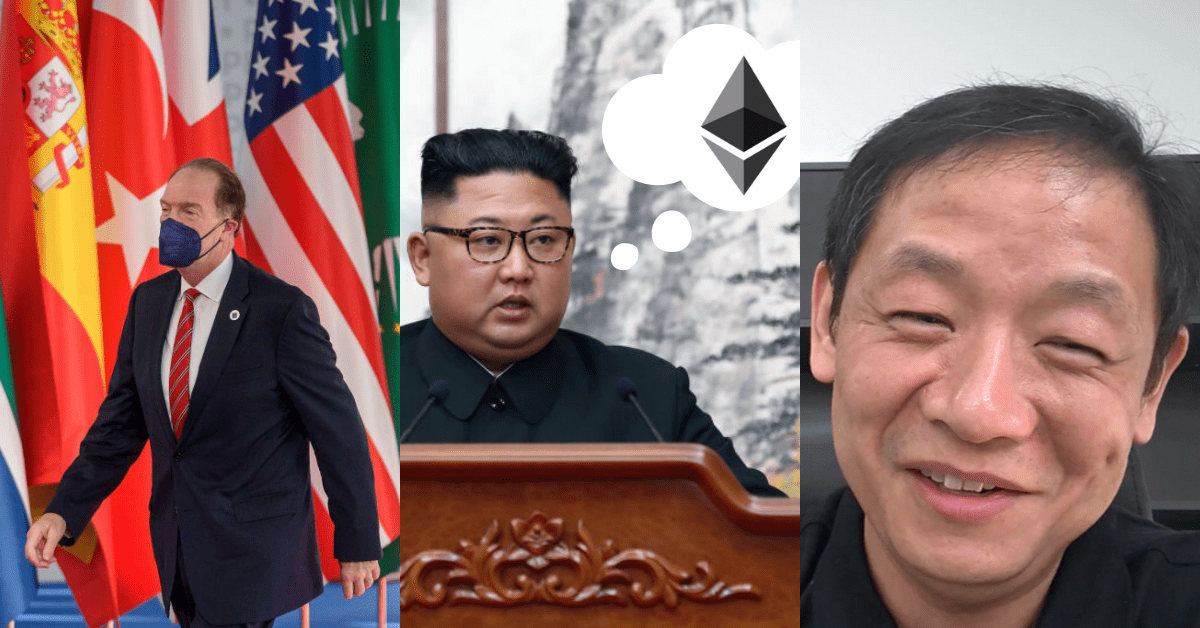In this issue
- Crypto market boost: Thank the bank
- Ronin hack: Peril from Pyongyang
- Chinese NFTs: End days for trading?
From the editor’s desk
Dear Reader,
Some investors in the cryptocurrency space share something in common with a number of those who criticize its volatility and perceived lack of value. Despite the fact that the two groups are on opposite sides of the fence when it comes to their support for the sector, for both, it’s pretty much just a game.
The fervor among memecoin enthusiasts, for instance — such as those awaiting this week’s “Doge Day” with puppy-like anticipation and high hopes for a spike in the joke-coin’s value — almost makes the crypto-skeptics’ point for them.
Yet as we have increasingly seen, the joke might be on both groups at their respective far reaches of the digital asset attitude spectrum, for crypto these days is anything but a game.
As the World Bank this week announced a hefty US$170 billion emergency funding package to address the current perfect storm of war, plague and famine (now wearily familiar to most of us as Russia’s war on Ukraine, the Covid-19 pandemic and surging inflation) there was a rare bright spot as Bitcoin enjoyed a bump in its value, alongside many other cryptos. Equity indices also ticked up on the news.
In previous editions of The Current Forkast, we noted the increasing correlation between crypto and traditional finance, and the reaction of both sets of markets to this week’s move by the World Bank underscores that dynamic.
Yet even though the vast majority of the crypto community regards the industry as a serious development in the future of finance, its “game” connotations are more than just imaginary.
A recent hack of Ethereum’s Ronin bridge blockchain, on which the immensely popular play-to-earn game Axie Infinity runs, saw only one alleged winner: North Korea, which this week was accused by the U.S. of having been behind the US$620 million heist.
Axie Infinity may give its player community plenty of fun (and in some cases livable sums of money), but Pyongyang’s track record of using attacks on crypto exchanges is reportedly one means by which it is funding its nuclear and ballistic missile program.
Either you think crypto is a joke or it’s a serious threat, but it cannot be both at the same time. The reality is that it’s here to stay — and its expanding role is being defined by all of us.
Until the next time,
Angie Lau,
Founder and Editor-in-Chief
Forkast
1. Relief rally

By the numbers: World Bank — over 5,000% increase in Google search volume.
Terra LUNA led a crypto market recovery on Monday as the World Bank unveiled a US$170 billion relief package while slashing its 2022 global growth forecast.
- At its Spring Meetings, the bank cut its global growth prediction for 2022 from 4.1% to 3.2% in response to Russia’s war in Ukraine, the persistence of the Covid pandemic, and galloping inflation.
- The bank is preparing its new 15-month crisis response fund to cover the period until next June, and it’s an even larger cash injection than the US$93 billion package it doled out just four months ago.
- The stimulus sparked a crypto market surge that saw Bitcoin spike above US$41,000 on Tuesday Hong Kong time. The world’s oldest crypto was trading at US$41,427 at press time.
- Other cryptocurrencies also enjoyed a price bump, with up-and-coming non-fungible token (NFT) and lifestyle project STEPN (GMT) hitting a new peak of US$3.79 in a surge of 44%. GMT has soared 598% over the past month.
- Terra’s LUNA rebounded 18.5% on Tuesday and was trading at US$94.70 at press time.
- Terra’s UST stablecoin is now the third-largest crypto by market capitalization.
Forkast.Insights | What does it mean?
For diehard crypto libertarians, the market’s recent recovery may be a little difficult to swallow. A cash injection from the World Bank designed to bolster a flagging global economy has had the effect of helping to restore confidence in crypto markets.
Crypto’s very origins lie in the quest for a decentralized, democratizing financial system that didn’t rely on governments or bodies such as central banks and others to keep the lights on. That message is frequently found inside blocks mined on the Bitcoin network.
Yet cryptocurrencies are inextricably intertwined with macroeconomic forces, which compromises the ability sought by its evangelists to resist real-world influences such as inflation and wars. Although some lament the increasingly obvious loss of crypto’s aspirational isolation from the push and pull of such things, it should be seen as a relatively low price of admission for its growing global acceptance.
All assets are affected by the world around them. Crypto’s influences have included cycles of hype and overpromising, and the star power of big-name investors adding them to their portfolios, alongside more fundamental market dynamics.
This isn’t a bad thing. It demonstrates that part of crypto’s value lies in its ability to function as a credible destination for investment. The remainder of its value comes from applications that solve problems Web 2.0 hasn’t been able to crack. This points to the persistence of its strong independent streak.
2. Money for missiles

By the numbers: Lazarus — over 5,000% increase in Google search volume.
North Korean hackers have been accused by the U.S. Federal Bureau of Investigation and Treasury Department of masterminding last month’s US$620 million hack on the Ethereum Ronin chain that powers play-to-earn game Axie Infinity.
- The FBI said last week that hacking groups named Lazarus and APT38, outfits associated with the regime in Pyongyang, were responsible for the theft of US$620 million of Ethereum on March 29, and Treasury added new sanctions against the Ethereum wallet owned by Lazarus on the same day.
- The Ronin network, an Ethereum sidechain, was breached on March 23, and around 173,600 ETH and 25.5 million USDC were snatched.
- The attack has delayed Axie Infinity’s Origin upgrade, originally scheduled for April 7. It is now expected to take place by the end of next week.
- In 2021, hackers backed by Pyongyang stole nearly US$400 million worth of cryptocurrencies, according to a report by blockchain data analysis platform Chainalysis released in January.
Forkast.Insights | What does it mean?
Although North Korea’s economy is a byword for mismanagement and underdevelopment, its cyber-warfare capabilities are rather more advanced.
The accusation that the Lazarus Group was responsible for such a major crypto hack comes as no surprise to security experts. Pyongyang’s hackers have been honing their crypto attack skills for years.
In 2018, North Korea successfully built and deployed a piece of malware named AppleJeus, which poses as a cryptocurrency trading platform in order to steal funds from people attempting to use it. It has been wildly successful, netting some US$320 million of ill-gotten gains since it was set up.
With its recent exploits, the Lazarus Group is believed to have accumulated more than US$1 billion of stolen crypto, which raises the uncomfortable question for the Web 3.0 community that state-sponsored cyberattacks appear to be gathering pace.
The most profitable hacker groups have been based in Russia, with three-quarters of all ransomware attacks last year originating from the country. That sends a clear signal to other states facing sanctions by Western nations: There can be easy money in crypto for anyone willing to put in the dirty work.
3. NFT norms incoming

Despite the ongoing non-fungible token (NFT) craze in Asia, China will likely shut down speculative trading in the asset class, a Chinese state-backed NFT developer told Forkast in an exclusive interview.
- Yifan He, the CEO of Red Date Technology, one of the founding members of China’s state-backed Blockchain-based Service Network (BSN), said China would probably disallow the speculative trading of NFTs due to the associated financial risks.
- Although China has yet to impose regulations on the NFT market, state-owned media outlets have been sharply critical of speculation involving NFTs, a development that often foreshadows official policy. NFTs are now mostly referred to in China as “digital collectibles,” and multiple Chinese tech giants have pledged to curb speculation on their NFT platforms.
- Despite the uncertainty, China’s NFT market enjoyed significant growth last year, with more than 4.5 million digital collectibles issued with a combined value of around 150 million yuan (US$23.56 million), Shanghai-based think tank Suanli said in a recent report. Chinese brokerage Guosen Securities estimates that the mainland market will be worth 29.8 billion yuan by 2026 if the government refrains from clamping down on NFT resales.
- China’s tech giants have adopted self-regulation to restrict NFT trading, with Alibaba imposing a 180-day lock-in for NFTs before their resale, although numerous platforms that don’t stop users from immediately flipping NFTs still operate in the country.
- According to He, China’s digital collectibles exist in a legal gray area at the mercy of authorities, and those seeking to enter the space should be aware of the regulatory risks involved. “You can’t design them as something similar to financial products that people can trade and sell when their value goes up,” he said. “They can be easily banned at the end of the day.”
Forkast.Insights | What does it mean?
The unofficial chief of the BSN has made it clear that digital collectibles with the attributes of financial products will not be tolerated by Chinese regulators. In fact, three national-level self-regulatory associations in the banking, securities and internet finance industries last week urged their members to “resolutely curb” a wave of “financialization and securitization” in the NFT space.
The call from these industry lobbies is significant, as they were established by government regulators and their moves are reflective of official thinking. It echoes a development in the crypto industry just under a year ago, in which days before China intensified a crackdown on crypto mining and trading, two of the three associations warned against the risks of crypto trading.
If Chinese regulators opt to take a zero-tolerance approach to secondary marketplaces for digital collectibles, that will deal a blow to platforms that don’t impose resale restrictions, and the number of platforms affected could be high. According to He, more than 90% of the 300 Chinese NFT companies built using BSN technology are engaged in activities associated with digital collectibles.
One area that Chinese regulators will likely focus on is trading frequency. If the authorities are looking to legalize NFT trading and recognize them as commodities, they may find themselves needing to follow the big industry players’ lead — and set timeframes for resales to preempt speculative behavior to which they’re so averse.




